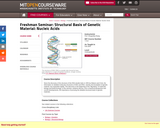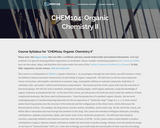This course is a continuation of Organic Chemistry I. The student will focus on four most important classes of reactions: electrophilic substitution at aromatic rings, nucleophilic addition at carbonyl compounds, hydrolysis of carboxylic acids, and carbon-carbon bond formation using enolates. The enolate portion of this course will cover the reactivity of functional groups. The student will also look at synthetic strategies for making simple, small organic molecules, using the knowledge of organic chemistry accumulated thus far. This course also introduces biological molecules, including carbohydrates, peptides and proteins, lipids, and nucleic acids, from a molecular perspective. The student will learn how chemical reactions, especially oxidation and reduction reactions, form the basis of all life. Note that in biology, the student would study the functionality of these structures by asking, 'How do they operate?' whereas in the field of organic chemistry, the student will ask: 'What are they made of?' The student will conclude this course with a unit on spectroscopy. Upon successful completion of this course, the student will be able to: Identify the chemistry and basic mechanisms of the following functional groups: ethers, epoxides, thiols, sulfides, benzene, amines, aldehydes, ketones, and carboxylic acids and their derivatives; Plan the synthesis of unsymmetrical ethers, amines, and carboxylic acid derivatives (esters, amides, etc.); Predict the product(s) of an electrophilic addition reaction involving conjugated dienes; Use the Diels-Alder reaction on conjugated dienes to form new carbon-carbon bonds and chiral centers of a desired configuration (R or S); Determine whether a molecule is aromatic, non-aromatic, or anti-aromatic; Indicate the position in which an electrophile will be added on an aromatic ring, given the other substituents present; Identify the products and mechanisms of electrophilic and nucleophilic aromatic substitution reactions; Demonstrate mastery of enolate chemistry and techniques for C-C bond formation; Plan the synthesis of simple molecules using the reactions learned throughout both the Organic Chemistry I and Organic Chemistry II courses; Describe the chemistry associated with biological molecules such as amino acids, nucleic acids, lipids, and carbohydrates; Identify different monosaccharides, disaccharides, aldoses, and ketoses, as well as reducing and non-reducing carbohydrates; Identify the twenty naturally occurring amino acids and describe the mechanisms associated with peptide cleavage and synthesis; Use spectroscopy (mass spectrometry, UV-Vis spectrometry, infrared spectrometry, and nuclear magnetic resonance) to characterize an organic molecule. (Chemistry 104; See also: Biology 108)






